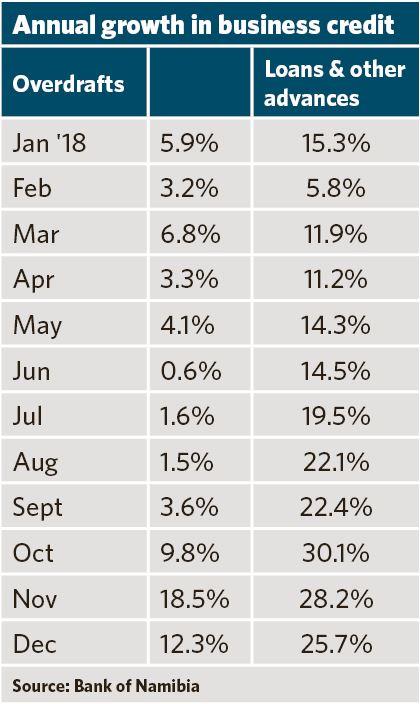Business credit spree continues
The IJG Business Climate Monitor fell by 1.2 points to 51.21 in October, marking its sixth consecutive month of decline.
Jo-Maré Duddy – The business sector in Namibia last year borrowed more than N$2 billion in overdrafts, loans and other advances from local banks.
Data released by the Bank of Namibia (BoN) shows business’ total debt for loans and advances – which includes credit card debt and personal loans – reached nearly N$6.3 billion by the end of December. This is nearly N$1.3 billion or 25.7% higher than the end of 2017.
In 2017, business’ total loans and advances debt grew by a mere 3.8% or N$184.5 million on an annual basis.
Commercial overdraft debt at the end of 2018 stood at about N$9.2 billion, up nearly N$1.01 billion or 12.3% the year before. In 2017, overdraft debt increased by 4.2% or about N$333.9 million year-on-year (y-o-y).
In contrast, the total mortgage loan debt of the business sector grew by only 2.6% y-o-y in December, compared to 8.5% in December 2017. By the end of last year, the sector’s total mortgage loan debt was more than N$11.6 billion.
Business continued to be cautious about instalment credit. By the end of December, the sector owed nearly N$4.4 billion in instalment credit, about N$461.5 million or 9.5% less than the end of 2017. In December 2017, annual growth in instalment credit was -6.1%. The business sector has slashed its total instalment credit debt by about N$778 million since the end of 2017.
Overall, the business sector owed commercial banks nearly N$38.7 billion at the end of last year, nearly N$2.4 billion or 6.5% more than the end of 2017.
Confidence
The IJG Business Climate Monitor (BCM) for October 2018, released yesterday, showed yet another retreat. The BCM fell by 1.2 points to 51.21, marking its sixth consecutive month of decline.
In contrast, the Leading Indicator, which predicts the future trend, showed its strongest improvement of 2018, IJG says, gaining 3.6 points to reach 47.40 points.
“This is the second highest reading in 2018 after February (47.92). We expect the Leading Indicator to continue its upward trend. The strong performance of the Leading Indicator suggests that the IJG BCM could have reversed its downward trend in the last two months of 2018,” IJG says.
Out of the 31 indicators used in compiling the IJG BCM, 14 dropped while 16 moved upwards with one staying flat in October. “This was the second lowest number of indicators that declined in 2018 after 13 declined in June,” IJG says.
While copper and gold production increased in October, diamond and uranium production dropped. The number of livestock marketed declined further in October, but beef and lamb prices improved.
The number of vehicles sold dropped to its lowest level in almost a decade and the value of building plans approved in Windhoek remained below average for 2018.
Total exports picked up slightly compared to September, while total imports decreased slightly resulting in a trade surplus.
The Namibia dollar weakened against the US dollar and Euro after some gains in September. Credit to both individuals and private businesses rose, IJG says.
Data released by the Bank of Namibia (BoN) shows business’ total debt for loans and advances – which includes credit card debt and personal loans – reached nearly N$6.3 billion by the end of December. This is nearly N$1.3 billion or 25.7% higher than the end of 2017.
In 2017, business’ total loans and advances debt grew by a mere 3.8% or N$184.5 million on an annual basis.
Commercial overdraft debt at the end of 2018 stood at about N$9.2 billion, up nearly N$1.01 billion or 12.3% the year before. In 2017, overdraft debt increased by 4.2% or about N$333.9 million year-on-year (y-o-y).
In contrast, the total mortgage loan debt of the business sector grew by only 2.6% y-o-y in December, compared to 8.5% in December 2017. By the end of last year, the sector’s total mortgage loan debt was more than N$11.6 billion.
Business continued to be cautious about instalment credit. By the end of December, the sector owed nearly N$4.4 billion in instalment credit, about N$461.5 million or 9.5% less than the end of 2017. In December 2017, annual growth in instalment credit was -6.1%. The business sector has slashed its total instalment credit debt by about N$778 million since the end of 2017.
Overall, the business sector owed commercial banks nearly N$38.7 billion at the end of last year, nearly N$2.4 billion or 6.5% more than the end of 2017.
Confidence
The IJG Business Climate Monitor (BCM) for October 2018, released yesterday, showed yet another retreat. The BCM fell by 1.2 points to 51.21, marking its sixth consecutive month of decline.
In contrast, the Leading Indicator, which predicts the future trend, showed its strongest improvement of 2018, IJG says, gaining 3.6 points to reach 47.40 points.
“This is the second highest reading in 2018 after February (47.92). We expect the Leading Indicator to continue its upward trend. The strong performance of the Leading Indicator suggests that the IJG BCM could have reversed its downward trend in the last two months of 2018,” IJG says.
Out of the 31 indicators used in compiling the IJG BCM, 14 dropped while 16 moved upwards with one staying flat in October. “This was the second lowest number of indicators that declined in 2018 after 13 declined in June,” IJG says.
While copper and gold production increased in October, diamond and uranium production dropped. The number of livestock marketed declined further in October, but beef and lamb prices improved.
The number of vehicles sold dropped to its lowest level in almost a decade and the value of building plans approved in Windhoek remained below average for 2018.
Total exports picked up slightly compared to September, while total imports decreased slightly resulting in a trade surplus.
The Namibia dollar weakened against the US dollar and Euro after some gains in September. Credit to both individuals and private businesses rose, IJG says.





Kommentaar
Republikein
Geen kommentaar is op hierdie artikel gelaat nie